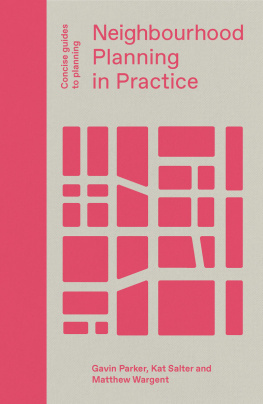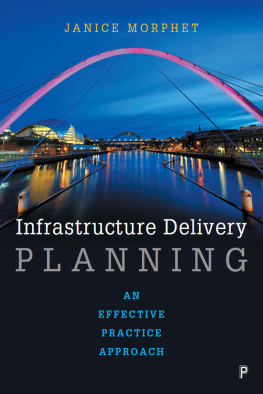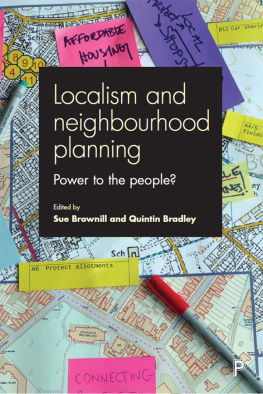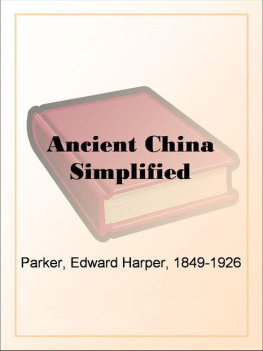First published in 2019 by Lund Humphries
Lund Humphries
Office 3, Book House
261A City Road
London EC1V 1JX
UK
www.lundhumphries.com
Neighbourhood Planning in Practice
Gavin Parker, Kat Salter and Matthew Wargent, 2019
All rights reserved
ISBN (hardback): 9781848222830
ISBN (eBook PDF): 9781848222847
ISBN (eBook ePub): 9781848223110
ISBN (eBook ePub Mobi): 9781848223127
Concise Guides to Planning (Print): ISSN 25168177
Concise Guides to Planning (Online): ISSN 25168185
A Cataloguing-in-Publication record for this book is available from the British Library.
All rights reserved. No part of this publication may be reproduced, stored in a retrieval system or transmitted in any form or by any means, electrical, mechanical or otherwise, without first seeking the permission of the copyright owners and publishers. Every effort has been made to seek permission to reproduce the images in this book. Any omissions are entirely unintentional, and details should be addressed to the publishers.
Gavin Parker, Kat Salter and Matthew Wargent have asserted their right under the Copyright, Designs and Patent Act, 1988, to be identified as the authors of this work.
Designed by Stefi Orazi Studio
Cover illustration by Stefi Orazi
Set in Favorit
Image credits
p.61 (top) ECA Architecture | Planning | Community and Boscombe and Pokesdown Neighbourhood Forum, (bottom) ImaginePlaces Ltd working with Kentish Town Neighbourhood Forum; p.62 Stowey Sutton Neighbourhood Planning Group; p.78 ImaginePlaces Ltd working with Elephant and Walworth Neighbourhood Forum; p.79 Planning Aid England; p.80 Colyton Neighbourhood Planning Group; p.82 Malborough Neighbourhood Planning Group; p.95 Jake McNulty and the Buckingham & Winslow Advertiser; p.128 Feria Urbanism, Swale Borough Council and Faversham Town Council.
Contents
Foreword
Preface and Acknowledgements
Chapter 1
Introduction
Chapter 2
What is Neighbourhood Planning?
Chapter 3
Communities and the Planning System
Chapter 4
Relationships in Neighbourhood Planning
Chapter 5
Stages of Neighbourhood Planning
Chapter 6
Challenges in Neighbourhood Planning
Chapter 7
Opportunities and Ideas for Neighbourhood Planning
Chapter 8
Reflecting on Neighbourhood Planning
Chapter 9
References, Resources and Further Information
Glossary
Foreword
This inspiring book will be a boon for those wanting to find out more about how to become engaged with Neighbourhood Planning. It is written by a uniquely well-qualified team of experts who have been involved with local groups over many years. Targeted primarily at what they refer to as the citizen-planner those members of the community coming new to plan-making the book reveals the opportunities and limits involved, by navigating through the process of creating a Neighbourhood Plan from start to finish. This introduction to Neighbourhood Planning will also be useful to professional planners wanting to know more about what is involved for them and also to students coming new to the subject. The text is lively and engaging, full of insights from practice, illustrated with a series of case studies and vignettes about how different groups have sought to make Neighbourhood Planning work for their localities. Read, enjoy, reflect and share.
Graham Haughton, Series Editor
Preface and Acknowledgements
This book focuses on the particular Neighbourhood Planning initiative that has been promoted in England since 2010. There are, of course, valuable experiences and lessons that have been drawn from similar forms of community engagement in planning in England and elsewhere, however the detailed review and advice here relates specifically to Neighbourhood Planning as constituted under the Localism Act (2011).
Neighbourhood Planning has been taken up by thousands of communities across England since it was first piloted. This new cohort of citizen-planners has found the experience empowering but also challenging. This is hardly surprising given that planning is a complex undertaking and the issues at hand are rarely resolved to the satisfaction of all parties. It is useful to note that the term citizen-planner is one that we have adopted here to indicate those individuals who voluntarily engage deeply with formal planning and, most pertinently here, Neighbourhood Planning. The Neighbourhood Planning initiative is subject to a variety of constraints (not least the need to conform to existing planning policies) and often unpredictable variables (such as modifications made to regulations and changes in local circumstances). As a result navigating the Neighbourhood Planning space can be difficult.
Most citizen-planners therefore embark on a journey of learning about their own community, the planning system, and any number of wider issues that impact on their own patch. There is also a range of important relationships with local and national institutions that need to be nurtured. This book seeks to explain some of these issues and is particularly directed towards those considering or already undertaking Neighbourhood Planning. The coverage includes what to look out for, how to navigate the system, important relationships to develop and maintain, and the resources necessary to help produce a successful Neighbourhood Plan.
We have adopted a critical but supportive stance, explaining the types of issues and obstacles facing citizen-planners as shown through research and practice-based experience. We highlight ways to overcome difficulties and the benefits that can be secured. The authors have direct experience of supporting and researching Neighbourhood Planning communities, and this experience is drawn upon in the case studies that illustrate the issues being discussed. A set of resources and online links is also provided to guide the reader further in support of this book.
We wish to thank the team at Lund Humphries for their support during the writing of this book. The text has been inspired by the ethos of Planning Aid England who has been supporting communities in planning since the early 1970s. We would like to thank all citizen-planners who have lent their experiences, many of whom have kindly given their time to our research over the past eight years. Particular thanks go to the group of Neighbourhood Planners who gave us feedback on earlier drafts. It is ultimately your enthusiasm, determination and effort that makes citizen-planning possible, and we hope that this book will encourage and inspire others in return.
















